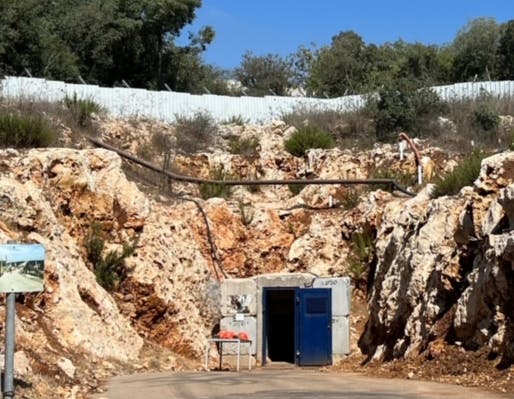Inside a Terrorist Tunnel, Between Lebanon and Israel
The temperature drops, and the stones are wet and slippery 260 feet under the border.

ZAR’IT, Israel — Under a hot September sun in northern Israel, we drove to a hilly rural village dotted by tidy homes surrounded by fragrant fruit trees and a secret tunnel connecting two countries long at odds with one another.
I was a few hundred yards from the border of Lebanon, where Hezbollah, an Iranian-aligned terror group, is deeply embedded in both the government and everyday life and remains a persistent threat to Lebanon and its neighbors.
When in 2018 the Israel Defense Forces discovered a network of underground tunnels along its northern border with Lebanon, concerns arose in the Middle East and at Washington. The discovery of multiple tunnel systems that connected two sovereign countries was an alarming escalation.
During this time, I served as the State Department spokeswoman and made it a priority to publicly highlight this worrisome find. But it wasn’t until four years later that I saw it firsthand. And let me just say, it was an eye-opening experience.
Lieutenant Colonel Sarit Zehavi, who studies northern border security for the Alma Research Center in Israel, estimates that the tunnels from Lebanon are nearly a hundred miles long and contain underground command and control rooms, weapons, supply depots, field clinics, and shafts used to fire missiles of all types.
After meeting with Colonel Zehavi, I, along with a bipartisan group of former American officials, carefully stepped into a dark, damp tunnel to explore one of the most important stories in geopolitics. We descended underground, walking carefully as the steps were steep, slippery and wet from water seeping through the limestone walls.
Strung along the tunnel walls are thick cables powering lights. The electricity hummed as I held onto handrails to guide my step down the spiral stairs. For anyone claustrophobic, this was not a comfortable journey. The tunnel was narrow yet wide enough to fit fighters carrying weapons and equipment, and that was the entire point.
The temperature dropped the further we went, ultimately reaching a depth of 260 feet underground. The tunnel itself stretched nearly three-quarters of a mile long. At the halfway point, we had to stop. We were nearly under the Lebanese border, and that’s where Israel had blocked the remainder of the passage by filling the rest of the tunnel with cement to prevent Hezbollah from crossing.
This was not the only terror tunnel from Lebanon that was discovered by Israel in 2018. IDF pinpointed five other covert structures intended for a possible ground war against Israel and its people, said the IDF. Hatred remains the motivation.
For ten years, Israel watched and waited while Hezbollah fighters used heavy equipment to drill through the hard underground rock. Tunnel detection sensors typically used along the Gaza Strip had picked up signs of unauthorized and unusual underground work.
While the instinct was to immediately stop the invaders, Israeli commanders knew that the underground tunnel would need to cross outside Lebanese territory before they could act. Once discovered, the other tunnels were filled with cement.
Yet the one we toured at Zar’it, just across the border from Ramie, Lebanon, remains partially intact for the world to see. Israel says that — to its knowledge — there are no other tunnels along the border, but when hatred runs this deep, an enemy remains persistent.

